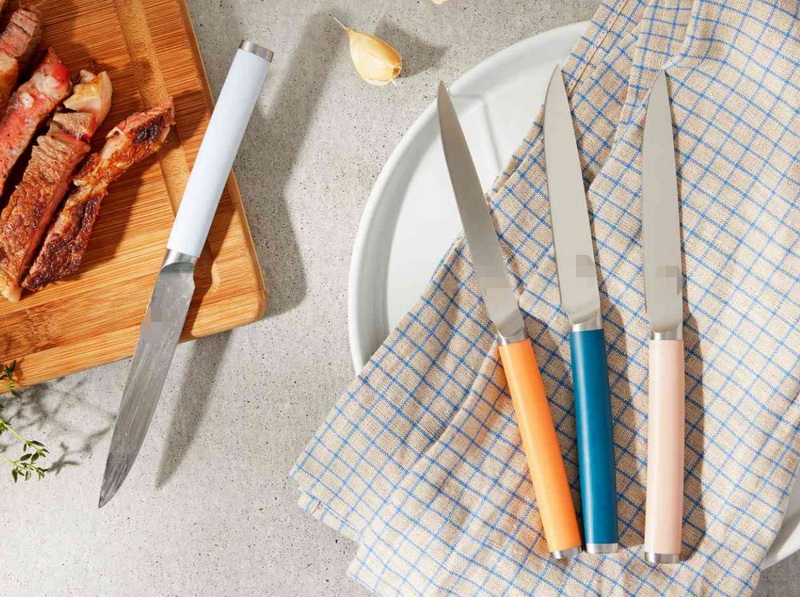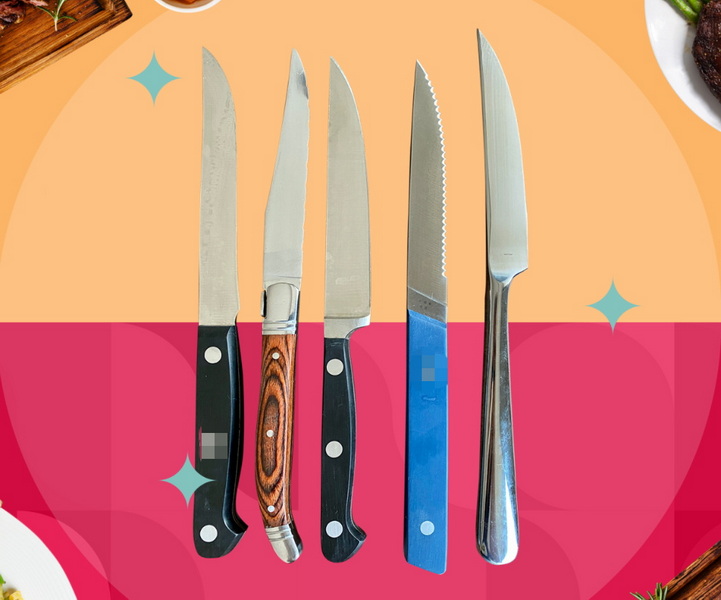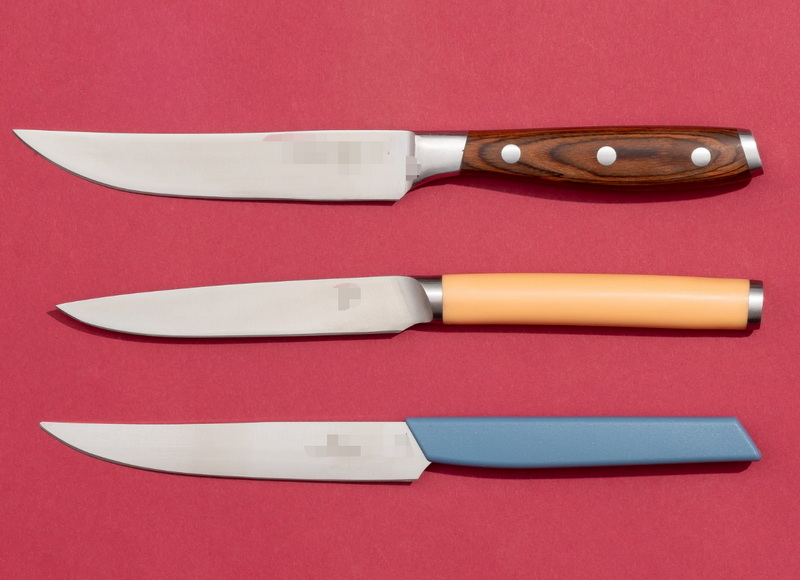- All
- Product Name
- Product Keyword
- Product Model
- Product Summary
- Product Description
- Multi Field Search
Views: 222 Author: Ann Publish Time: 2025-10-27 Origin: Site











Content Menu
● 1: Why a Quality Steak Knife Matters
● 2: Key Features of Top Steak Knives
● 3: Blade Materials and Geometry
● 4: Handle Design and Ergonomics
● 5: Knife Block, Storage, and Maintenance
● 6: Market Trends for Steak Knives in Home and Restaurant Segments
● 7: OEM Considerations for Foreign Brands
● 8: Comparative Guides: Styles and Regions
● 9: Buying Guide for Different Budgets
● FAQ
>> What blade material offers the best balance of sharpness and corrosion resistance for steak knives?
>> How does edge angle affect slicing through different meats?
>> Are Damascus steel blades suitable for restaurant use, considering maintenance?
>> What handle materials balance grip, durability, and washability in a busy kitchen?
>> What OEM considerations should foreign brands prioritize when sourcing steak knives?
A sharp, well-balanced steak knife is more than a tool; it is a gateway to consistent dining experiences. For both home cooks and restaurant professionals, the right knife translates into effortless cutting, pristine plating, and reduced waste. This article dives into the features that distinguish the best steak knives, examines blade materials and geometries, discusses handle design and ergonomics, and highlights OEM considerations for foreign brands seeking reliable knife supply chains. Throughout, we emphasize practical guidance for selecting, using, and maintaining steak knives to maximize performance and longevity.

A quality steak knife delivers a superior cutting experience that affects presentation, portion control, and yield. In high-volume kitchens, consistent slice quality reduces butcher waste and speeds up service. For home cooks, a reliable knife elevates everyday meals into restaurant-grade experiences. Key considerations include blade steel, edge retention, balance, and the ability to slice through different textures—bone-in ribeye, New York strip, or lean filet—with minimal tearing.
- Sharpness and edge retention: A steely cutting edge maintains sharpness longer, reducing frequent sharpening.
- Balance and weight: Proper balance minimizes wrist strain and enhances precision.
- Blade geometry: A well-conceived blade geometry influences meat separation and clean cuts.
- Handle ergonomics: Comfortable grips support prolonged use without fatigue.
- Corrosion resistance and durability: Stainless or powdered metallurgy steels help resist rust and staining.
- Alloying and heat treatment: Carefully selected alloys and tempered processes improve wear resistance and edge stability.
- Maintenance compatibility: Some knives tolerate dishwasher cycles, while others require hand washing and careful drying.
Blade materials influence performance, durability, and care. Common choices include high-carbon stainless steel, VG-10, AUS-8, and advanced powdered steels. Damascus blades, with layered patterns, offer aesthetics plus robust performance when heat-treated properly. Geometry concerns blade profile, edge angle, and blade thickness. A typical kitchen steak knife uses a 15- to 18-degree edge per side, balancing sharpness and durability. A thinner blade excels at delicate cuts; a slightly thicker blade provides strength for tougher meats.
Handle design influences grip security and comfort during extended use. Materials range from synthetic composites to wood and polymer blends. Ergonomics considerations include finger grooves, palm swell, curvature, and balance points. A well-designed handle reduces fatigue, prevents slips, and allows natural wrist alignment during slicing. For professional kitchens, washable, durable handles with secure rivets and corrosion resistance are essential.
Edge protection begins with proper storage. Knife blocks, magnetic strips, and blade guards all contribute to edge life and safety. For OEM brands, packaging that communicates edge retention and corrosion resistance can influence purchasing decisions. Maintenance routines should include hand washing, thorough drying, and periodic sharpening with appropriate tools. A routine care plan helps ensure consistent performance and extends service life.

Global demand for premium steak knives reflects shifting consumer expectations toward durability, design, and brand storytelling. In home markets, consumers seek bundles that combine aesthetics with practicality, including knife blocks that suit compact kitchens and built-in sharpeners for convenience. Restaurants emphasize reliability, batch consistency, and ease of cleaning. Powdered steel blades and advanced heat treatments are increasingly popular due to improved edge retention and wear resistance. Custom branding and private-label options are attractive to international buyers seeking differentiation.
For foreign brands collaborating with Chinese manufacturers, several OEM considerations matter:
- Customization options: Logo engraving, handle material choice, blade finish, packaging design, and certificate of conformity.
- Minimum order quantities and lead times: Align production schedules with demand forecasts and seasonal spikes.
- Compliance and certifications: Food-contact approvals, safety standards, and steel grade specifications.
- Quality control: In-process inspections, spark test protocols, and end-of-line testing to ensure consistency.
- Logistics and supply chain: Transparent communication, cargo insurance, and contingency planning for port delays.
- After-sales support: Warranty terms and replacement parts to maintain brand trust.
- Japanese knives: Known for precision and sharpness, often with thinner blades and a keen emphasis on edge retention.
- German knives: Bulkier builds and robust edge geometry, suitable for heavy-duty cutting.
- Western/global variations: Balanced yet versatile, combining durability with comfort.
- Damascus and specialty blades: Aesthetic appeal with specialized performance traits.
- Blade angles and edge finishing: How different angles affect cutting dynamics and maintenance needs.
- Budget range: Entry-level knives that offer basic performance with durable materials and simple maintenance.
- Mid-range: Better materials, refined ergonomics, and improved edge retention for longer service life.
- Premium: High-end steels, optimized geometry, and customization options for brands seeking standout differentiation.
- For OEM buyers: Consider total cost of ownership, including maintenance needs, packaging, and lead times, to evaluate value beyond upfront price.
- Cleaning: Hand wash with mild detergent; avoid harsh abrasives.
- Drying: Thoroughly dry to prevent rust and corrosion.
- Sharpening: Use appropriate stones or tools; follow a consistent honing routine between sharpenings.
- Storage: Use protective sheaths or proper blocks to prevent nicks and injuries.
- Handling: Use proper cutting techniques to minimize stress on the blade and maintain edge integrity.
Premium steak knives deliver consistent performance across home kitchens and professional settings. By selecting blades with the right material, geometry, and ergonomic design, brands can deliver reliable tools that reduce waste, improve plating, and enhance customer satisfaction. OEM partnerships with manufacturers offering customizable options, strict quality control, and robust after-sales support can help foreign brands achieve faster time-to-market and stronger brand differentiation.

- Answer: High-carbon stainless steels with proper heat treatment provide an excellent balance of sharpness and corrosion resistance, making them suitable for daily restaurant and home use.
- Suggested H tag: ## What blade material offers the best balance of sharpness and corrosion resistance for steak knives?
- Answer: A finer edge angle (around 15–16 degrees per side) yields a sharper edge for tender meats, while a slightly steeper angle (around 18–20 degrees per side) increases durability for tougher cuts and heavy use.
- Suggested H tag: ## How does edge angle affect slicing through different meats?
- Answer: Damascus blades offer aesthetic appeal and excellent cutting performance, but they require more careful maintenance to prevent corrosion and edge inconsistencies. They are well-suited for high-end restaurant branding when a proper care routine is in place.
- Suggested H tag: ## Are Damascus steel blades suitable for restaurant use, considering maintenance?
- Answer: Polymer/nylon composites, high-stability plastics, and wood handles with stainless-steel fittings provide strong grip, durability, and washability. Look for non-slip textures and corrosion-resistant coatings for longevity.
- Suggested H tag: ## What handle materials balance grip, durability, and washability in a busy kitchen?
- Answer: Prioritize customization options (logo engraving, blade finish, handle material, packaging design), minimum order quantities, lead times, material certifications, and comprehensive after-sales support terms.
- Suggested H tag: ## What OEM considerations should foreign brands prioritize when sourcing steak knives?
The Ultimate Professional Knives for Halal Butchery in Middle Eastern Kitchens
Chef Knife Size Guide: Choosing Between 6″, 8″, 10″, And 12″
Custom Knife Handles: How To Design A Chef Knife That Fits Your Hand Perfectly
Chef Knife Surface Treatments Guide: From Polished Migaki To Damascus Patterns
Inside Our Professional Knife Sample Room: Quality You Can See
Universal Knife Block Buying Guide: Modern Acrylic & ABS Knife Holders for Professional Kitchens
Universal Knife Block: The Complete Guide To Modern, Hygienic Knife Storage
The Complete Guide To Red Handle Knife Sets: Style Meets Functionality in The Kitchen
Professional Knives for Halal Butchery And Middle Eastern Cuisine